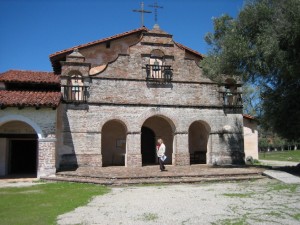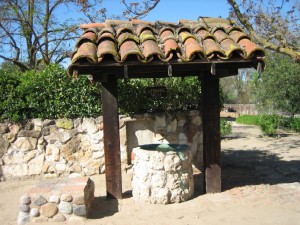 Relevant History welcomes Anne Schroeder, who served as President of Women Writing the West. Her award-winning fiction includes stories of bandits and bold women. She worked her way through college at a truck-stop café near where James Dean died. She lives in Southern Oregon with her husband, dogs and several free-range chickens. To learn more about her and her books, visit her web site, and follow her on Facebook.
Relevant History welcomes Anne Schroeder, who served as President of Women Writing the West. Her award-winning fiction includes stories of bandits and bold women. She worked her way through college at a truck-stop café near where James Dean died. She lives in Southern Oregon with her husband, dogs and several free-range chickens. To learn more about her and her books, visit her web site, and follow her on Facebook.
*****
The land of dons and doñas comes to an end
“Viva la independencia! Viva el Emperor Augustin I!” shouted the residents of Monterey while the Spanish flag was lowered in California’s capitol. A moment later the Mexican flag fluttered in the ocean breezes. The year was 1821. Swift riders were sent up and down California to spread the news.
 In pastoral ranchos across El Camino Real, the King’s Highway, from Sonoma to San Diego, Spanish ladies put away their black taffeta dresses, high hair combs and mantillas. They loosed their severe braids and adopted brightly-colored skirts and blouses that suited an informality of attitudes that accompanied the fall of influence from the Catholic Church. Padres were banished, some to a Spain they had never seen. Mission tools, food stores and livestock were sold to cover the current governors’ gambling debts. Horses were driven off by the thousands, sold to the U.S. army in Arizona for use in the Plains Wars. The Indians were emancipated, with nowhere to go.
In pastoral ranchos across El Camino Real, the King’s Highway, from Sonoma to San Diego, Spanish ladies put away their black taffeta dresses, high hair combs and mantillas. They loosed their severe braids and adopted brightly-colored skirts and blouses that suited an informality of attitudes that accompanied the fall of influence from the Catholic Church. Padres were banished, some to a Spain they had never seen. Mission tools, food stores and livestock were sold to cover the current governors’ gambling debts. Horses were driven off by the thousands, sold to the U.S. army in Arizona for use in the Plains Wars. The Indians were emancipated, with nowhere to go.
Three new governors were appointed in four years. Complaints about each flew between Mexico City and Monterey. Traditional pride ignited old rivalries, but the conflicts were undertaken with honor and decorum as brother raged against brother, nephew against uncle. Some of the actions, recounted later, seemed almost courtly. General Mariano Vallejo was imprisoned for months during the Bear Flag Revolt, until his wife won his release with daily gifts for his accusers of wine and delicacies from the General’s rancho.
Conflicting Californians clashed, and one was killed by countrymen near Santa Barbara. Widows of the great Spanish dons, interviewed for the Bancroft Project years later, expressed the opinion that civil war seemed inevitable and was only avoided because the Americans took control. Perhaps the Californians turned their energies to a common enemy.
Spanish land grants, conveyed by a handshake and a promise, were set aside by Mexican courts. Spanish dons, unable to provide a written deed, lost their lands to loyal Mexicans, many of whom later lost their own claim in American courts. In canyon and arroyo, greed descended. Gone, the fiestas with their fierce combat between a lassoed grizzly tied to the leg of a wild longhorn bull. The bucolic life of pastoral California had come to an end.
The “Time of the Troubles”
The Indians in both Alta and Baja California suffered greatly. During the Colonial rule, Franciscan monks under the leadership of Padre Junipero Serra had traveled from Spain to set up a chain of Missions to instruct the natives. By decree of the King, they were to produce worthy Spanish subjects. They were to baptize, instruct in music, prayer, teach matters of hygiene and modest dress. They were to teach methods of European farming and stock management that would provide for the gente de razón (people of reason, the Spanish people) living in California as well as the benefactors of the expedition, the Spanish court. Each Mission was supplied with five soldiers who were to protect and administer punishment. Families were encouraged to immigrate and procreate, with families producing over twenty children. Outposts at the edge of the world, the immigrants were cut off from civilization except for a Spanish ship that arrived each year with supplies to be paid for with hides.
 When Spain went to war against her European neighbors, Indians were pressed to their limits to provide leather, gold, food and raw materials for Spain. During the first years, padres ministered to the curious Indians who gathered at the edge of the trees and watched the greyrobes offer prayers to a God that was more powerful than their traditional gods. As Indian neophytes, Christians, died of sickness and overwork, the soldados de cuero, leather jacketed Mission guard, rode further into the countryside rounding up replacements with ropes and sticks. The neophytes singed their hair with hot coals and grieved their loss of freedom. Some escaped, only to be rounded up and severely punished by soldiers tasked with strict quotas set by the Spanish king and, later, by the taxes needed to pay salaries of the Mexican administrators. What began as a ten-year plan to train Indians stretched into a fifty-year joint venture that became increasingly difficult for everyone.
When Spain went to war against her European neighbors, Indians were pressed to their limits to provide leather, gold, food and raw materials for Spain. During the first years, padres ministered to the curious Indians who gathered at the edge of the trees and watched the greyrobes offer prayers to a God that was more powerful than their traditional gods. As Indian neophytes, Christians, died of sickness and overwork, the soldados de cuero, leather jacketed Mission guard, rode further into the countryside rounding up replacements with ropes and sticks. The neophytes singed their hair with hot coals and grieved their loss of freedom. Some escaped, only to be rounded up and severely punished by soldiers tasked with strict quotas set by the Spanish king and, later, by the taxes needed to pay salaries of the Mexican administrators. What began as a ten-year plan to train Indians stretched into a fifty-year joint venture that became increasingly difficult for everyone.
The later period from the Mexican era through the first years of the American conquest, became known to the People as the “Time of the Troubles.”
This is the setting of my novel, Maria Ines. Maria is a Salinan Indian girl born under Padre Serra’s cross at Mission San Miguel Arcángel. She witnesses the political intrigue and greed of Spanish, Mexican and Yanqui invaders who plunder California, destroying everything she loves. A refugee in her own land during the Time of the Troubles, Maria Ines struggles to survive while she reclaims her family, her faith, and her ancestral identity.
*****
 A big thanks to Anne Schroeder. She’ll give away an advanced reader copy (ARC) of Maria Ines to someone who contributes a comment on my blog this week. I’ll choose the winner from among those who comment by Friday at 6 p.m. ET. Delivery is available in the U.S. and Canada.
A big thanks to Anne Schroeder. She’ll give away an advanced reader copy (ARC) of Maria Ines to someone who contributes a comment on my blog this week. I’ll choose the winner from among those who comment by Friday at 6 p.m. ET. Delivery is available in the U.S. and Canada.
**********
Did you like what you read? Learn about downloads, discounts, and special offers from Relevant History authors and Suzanne Adair. Subscribe to Suzanne’s free newsletter.
